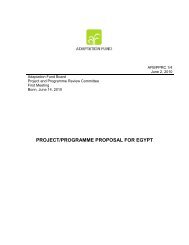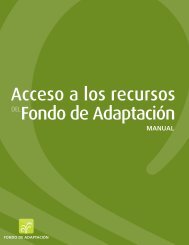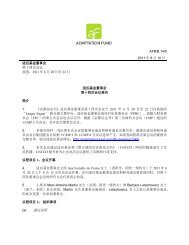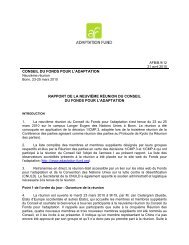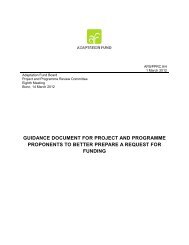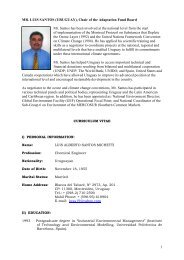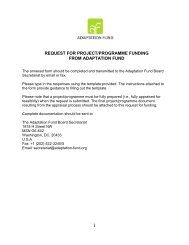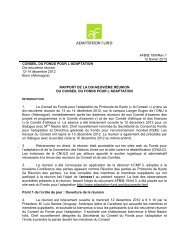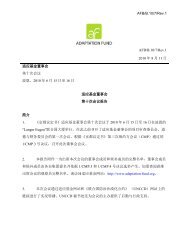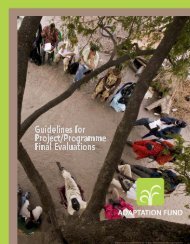PROPOSAL FOR MALI - Adaptation Fund
PROPOSAL FOR MALI - Adaptation Fund
PROPOSAL FOR MALI - Adaptation Fund
You also want an ePaper? Increase the reach of your titles
YUMPU automatically turns print PDFs into web optimized ePapers that Google loves.
crops are sorghum, millet and rice which might experience a decrease in production of 18-33percent with a decrease in rainfall. In addition, a fall in production is accompanied by adecrease in economic output. Food production losses associated with the 1984 Saheldrought in Mali accounted for a loss of 9 percent of GDP. 12 An examination of rainfallanomalies and changes in domestic rice production reveals that these are directly andpositively correlated. A simulation exercise (assuming an increase in temperature of between1 and 2.75 o C and no adaptation measures) suggests that a decrease in cereal harvestswould result in a doubling of food prices in Mali by 2030. Reduced local agricultural outputand higher food prices will reduce access to food, particularly for the very poor, and increasethe risk of hunger from the present baseline of 34 percent of the population to 64-70 percentby 2030. 13Problem Statement: The Climate Change-induced ProblemThe recently developed National Policy, Strategy and Action Plan on Climate Change forMali (AEDD 2011) clearly states government recognition of the problem of climate change bythis problem statement:„In Mali, climate change threatens key sectors of the economy: Agriculture, Livestock,Fisheries, Forestry, Energy, Health, and Infrastructure. Without an organized response andanticipated level of governance of these sectors to address these challenges, climate changecould be very threatening on the development of Mali.’ The document further recognizes thefact that ‘up to date the level of anticipation of the risk of climate change in sectoral policies isnot the same across all the sectors. Even the actions and initiatives at the sectoral level tomake up for it and to integrate climate change risks and opportunities are limited anddeserve more interest and human and financial resources of a higher dimension. Thisapplies to both adaptation to climate change and mitigating emissions and the use of a cleanand sustainable development projects.‟Mali experiences severe recurrent shocks particularly droughts, locust infestation andirregular rainfalls causing reduction in agricultural yields and water resources severelyaffecting the livelihoods of the people and national development. There are also extremeclimate events such as flooding. The NAPA assessment, for example, concluded that climatechange is likely to cause significant losses in crop production (like millet, sorghum, maizeand rice) by 2025 and 2050. This demonstrate that farming systems in Mali are extremelyvulnerable to climate change and climate variability.The root causes of vulnerability include significant reliance on rain-fed production systems,ongoing practices of crop and livestock selections, water resource management, rangelandmanagement, drought illpreparedness, and household income generation that are notcompatible with increasing impacts of climate change. Other drivers of vulnerability include:(i) increasing demographic trends e.g. climate-induced refugee movements into regions leastaffected by drought, which cause intense pressure on productive arable lands; (ii) shortageof basic investment in market instruments in rural areas (such as access to credit, limitedmarket outlets, etc.); and (iii) lack of land tenure regulation that hinders development of thethe sector. In the context of the above root causes, the performance of production systems(agriculture, fisheries, livestock, forestry etc.) and the capacity to adapt are limited.The fragile ecosystems of the country are very vulnerable to extreme climate eventsweakening the socio-economic situation and the ability of communities to adapt.12 World Conference on Disaster Reduction, 199412 UNDP 2011. Human Development Report 2011 Sustainability and Equity: A Better Future for All13 Butt et al. 200318



